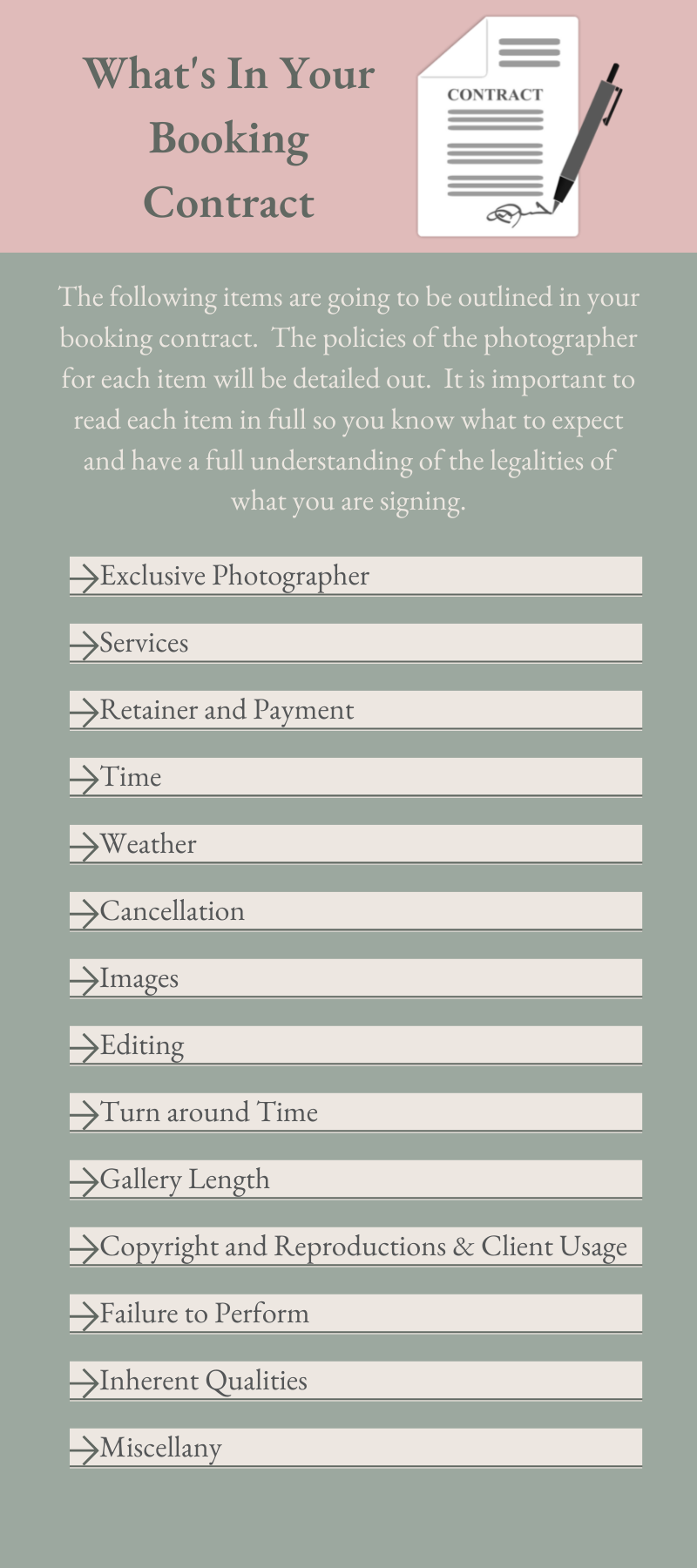The Importance of Reading your Booking Contract
Portrait Photography in Elk Grove, Ca.
We have all done it. We get asked to approve of the terms and conditions for a social media app or maybe it is for the new iPhone, so we hurriedly scroll to the bottom and hit submit. Do we read it word for word? NO. Do we fully understand what we just agreed to? NO. But did you know that this is legal verbiage that protects the business as well as the consumer from certain liabilities and problems that may arise in the future. So, it important to keep in mind that a Photography Contract is also a legal document and by signing it, you are adhering to what is stipulated in that contract. A photographer doesn’t just throw something together for you to quickly sign. They want you to read carefully over the contract because it answers so many questions that you might have, as well as given you peace of mind about the protections that you will have legally.
The importance of a contract is undeniable because it clearly outlines the services being offered, and states policies about those services and defines expectations and a guideline about what can and can not be done. A Photography contract is not just about protecting the photographer, but you as the client. In the contract you signed, you will understand what your session will be like, how much it will cost, what you can do with your images, what is the time frame for turn around, and more.
I have had on occasion clients who did not fully read their contract and were upset and baffled when situations would arise, and they didn’t like the answers they were being given. The last thing me or any other photographer wants is for their client to not have an overall good experience and to walk away with a sour taste in their mouth. I want all my clients to go into their session fully aware of all the things that is expected of them, of me, and of their images. Each section of the contract should be read carefully and to have a clear understanding of what you are signing.
What are some items that a good photography contract should have?
Exclusive Photographer.
First and foremost, it should lay out the name of the photographer, and who the client is. The client will be legally responsible for signing the contract and for all payments.
Services.
Another prominent piece of the contract should be a clear statement of what the service is and what is included in that service or package, how much is the service or package, when are the payments due, and what date and time will the service be fulfilled.
Retainer and Payment.
This is the section where a photographer indicates what the services cost, if there is a deposit or retainer due, and when the balance is due. It is important to also make sure that it is stated as to what is refundable and not refundable.
Time.
With a service-based contract a photographer will outline what time the service will be performed at, and if there is any restrictions or penalties if the client arrives late to the session.
Weather.
Outdoor photographers will more than likely have a section in their contract related to the weather. Weather is unpredictable and it is important to have something in place that gives clients assurance of what happens if the weather disrupts their session and what remedies the photographer will put into place.
Cancellation.
This is a very important part to check over in your contract. We all know that life happens and sometimes things must be cancelled or postponed. It is important to know your photographer’s policy on cancelling the session, rescheduling the session, and what payments can be waived or are still owed.
Images.
A photographer may have a section where they outline what type of images they take and what will be released or not released to you. For example, if a photographer takes photos of a session using RAW, a client does not usually get these files. Most photographers give high resolution jpgs to their clients only. They may outline how they go about selecting the images and what you will and will not see.
Editing.
Not all photographers may have this in their gallery. If they do it might specify what type of editing the photographer will do on your images, and if they do any kind of retouching to the images.
Turn Around Time.
Patience is not always everyone’s strong suit lol. It is hard to wait and be patient for your images. Photographers will add a section in the contract to let their clients know how long it takes to edit the images and get them up on a gallery site. They may also specify what kind of time frame it will be to receive any print products that are ordered.
Gallery Length.
This section may or may not be included in a photographer’s contract. However, this is one of the sections that I feel is necessary and is often overlooked by clients. Photographers pay a fee to upload and store the images in a gallery format for their clients. Depending on the service the photographer uses can affect the length of time the gallery is active and if there is an additional charge to reactivate the gallery once it has expired. This section lets clients know the amount of time they must look through their images, make selections, and order any digital downloads or print products.
Copyright and Reproductions and Client Usage.
This is a section that can be a little confusing to some clients. There has been a lot of misunderstanding when it comes to photographer copyright laws. A lot of people believe that if they get their photos done, they own the images. However, that is not the case. Basically, copyright law says that when a photographer takes a photograph, they become the copyright owner of the image created. This means they hold exclusive rights to: Reproduce the photograph, Display the image in a public space, Distribute the photo, Create derivatives of the image. When a client hires the photographer, they may be purchasing a personal usage rights option with the photographer. This means that the client has very limited rights to the usage of the photos. Each photographer can have different verbiage or policies when it comes to their personal usage rights clause. Most specify that the client can print them, email them, and post them on social media. What clients can’t do is anything that would lead to financial gain such as selling their images etc. They also are not allowed to further edit the images. This is such a hard thing for clients, especially in the age of Instagram filters. Just know that you should NOT be adding any filters or extra edits to the images you receive from your photographer. When in doubt, ask for further clarification from your photographer before doing something with your images.
Failure to Perform.
This section relates to the cancellation or rescheduling portion of the contract. This may cover what happens if the photographer gets sick, has an emergency, an act of God, or maybe their equipment gets stolen, etc. They will add here what happens if they are unable to perform their function as the agreed upon Photographer.
Inherent Qualities.
As we all know photographs fade, labs have different processes, colors aren’t always 100% accurate and CD’s or DVD’s will at some point fail. A photographer will outline what their responsibility is in these situations and what releases the photographer from certain liabilities when it comes to these types of inherent qualities.
Miscellany.
This section may wrap up the agreement and give final directions or statements about the agreement.
No one likes to read a long document of legal stuff, but when it comes to your photography contract, I cannot stress enough how important it is to fully read and understand the contract before signing. You don’t want to skip and then have a situation come up after the fact that leaves you feeling frustrated and angry.
A photography contract doesn’t just protect the photographer, it protects you as the client. You will know what you are getting, when you are getting it, how you are getting it, what the liabilities are, what are the policies if something changes, etc. A contract outlines all the expectations for the course of the transaction and prevents potential miscommunications between parties. You as the client will have a roadmap of what to expect in the process without having to play five-hundred questions with the photographer. Make sure there are no misunderstandings and read the contract thoroughly before signing. When in doubt, ask for further clarification from your photographer.



